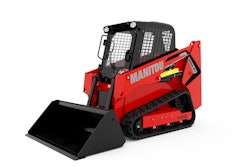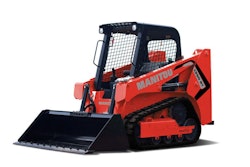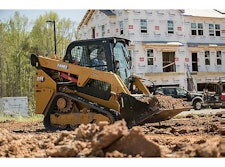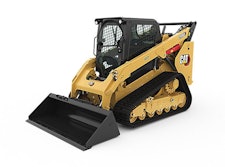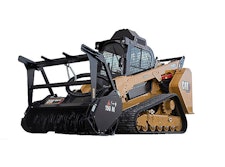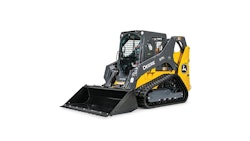Compact Track Loaders
A compact track loader (CTL) is a type of track loader that is smaller and lighter than traditional track loaders. They are handy for work on soft, wet, or muddy terrain where other machines might struggle to operate. One of the main advantages of a CTL is its ability to operate on a wide range of surfaces, including mud, sand, snow, and loose soil. It is due to the machine's rubber tracks, which provide more excellent traction and lower ground pressure than traditional wheeled machines. It makes them less likely to get stuck in the soft or muddy ground and reduces the potential for damage to their operating surface. Compact track loaders are a popular choice for construction and landscaping professionals due to their versatility, maneuverability, and ability to operate on various surfaces.
A compact track loader (CTL) is a type of track loader that is smaller and lighter than traditional track loaders. They are handy for work on soft, wet, or muddy terrain where other machines might struggle to operate.
One of the main advantages of a CTL is its ability to operate on a wide range of surfaces, including mud, sand, snow, and loose soil. It is due to the machine's rubber tracks, which provide more excellent traction and lower ground pressure than traditional wheeled machines. It makes them less likely to get stuck in the soft or muddy ground and reduces the potential for damage to their operating surface.
Compact track loaders are a popular choice for construction and landscaping professionals due to their versatility, maneuverability, and ability to operate on various surfaces.
A compact track loader (CTL) is similar to a skid steer loader in many ways, but they are different. The main difference between the two is the type of undercarriage they use.
A skid steer loader is a small, wheeled machine designed to be highly maneuverable in tight spaces. It is typically used for construction, landscaping, and agricultural applications. It is equipped with lift arms that can be fitted with various attachments, such as buckets, forks, and grapples.
On the other hand, a compact track loader is a machine with a tracked undercarriage, giving it more excellent traction and stability on soft or uneven terrain. It makes it ideal for construction, landscaping, and forestry applications. Like a skid steer, a CTL can be fitted with various attachments to perform different tasks.
While CTLs and skid steers share many similarities, they are designed for different applications and have different strengths and weaknesses. A CTL is generally better suited for soft or uneven terrain, while a skid steer may be better for complex, flat surfaces. Ultimately, the choice between a CTL and a skid steer will depend on the specific needs of the job at hand.
Buying a compact track loader or a skid steer will depend on several factors, including the type of work you plan to do, the terrain you will be operating on, and your budget. We'll go through them individually so that you can decide easily.
A compact track loader may be better if you plan to work on soft, wet, or uneven terrain. The tracked undercarriage of a CTL provides excellent traction and stability on these types of surfaces and can reduce the potential for damage to the ground.
A skid steer may be more suitable if you plan to work on hard, flat surfaces. The wheeled undercarriage of a skid steer is better suited for use on concrete, asphalt, or other hard surfaces and may provide better maneuverability in confined spaces.
The type of work you plan to do is also an important consideration. Both machines can be fitted with various attachments to perform different tasks, but some attachments may be better suited for one machine. For example, a brush cutter or mulcher may be more effective on a CTL, while a hydraulic breaker or sweeper may be better suited for a skid steer.
Finally, budget is an essential factor to consider. Compact track loaders cost more than skid steers due to their advanced undercarriage technology. However, it may be worth the investment if a CTL's added traction and stability are necessary for your work.
Buying a compact track loader or a skid steer will depend on your specific needs and budget. Researching both machines and consulting with equipment dealers or other professionals is an excellent idea to determine which machine is best for your needs.
The choice between a wheeled or tracked compact excavator depends on several factors, including the type of work you will be doing and the conditions of your worksite. Here are some considerations to help you make the decision:
Whether to buy a compact track loader or a compact wheel loader will depend on several factors, including the type of work you plan to do and the terrain you will be operating on. Let us explain it in detail to you.A compact wheel loader is a versatile machine that works on hard, flat surfaces such as pavement or concrete. Its wheeled undercarriage provides incredible speed and maneuverability than a track loader, making it ideal for landscaping, snow removal, and material handling. A wheel loader can also carry heavier loads than a track loader.
However, a compact track loader may be better if you plan to work on soft or uneven terrain. The tracked undercarriage of a CTL provides excellent traction and stability on these types of surfaces and reduces the potential for damage to the ground.
Additionally, the attachments available for a compact wheel loader differ from those available for a track loader. Wheel loaders are typically equipped with buckets or forks, while track loaders can be fitted with a broader range of attachments, including brush cutters, mulchers, and trenchers.
Ultimately, it all comes down to your specific needs and the terrain for this equipment. A wheel loader may be a better choice if you need more incredible speed and maneuverability on hard, flat surfaces. However, a track loader may be better if you need greater stability and traction on soft or uneven terrain. Researching both machines and consulting with equipment dealers or other professionals is vital to determine which machine is best for your needs.
There are several reasons why you might choose to buy a Compact Track Loader (CTL):
1- Greater traction and stability:
The tracked undercarriage of a CTL provides more excellent traction and stability on soft or uneven terrain than a wheeled machine. It is ideal for construction, landscaping, forestry, and other applications where the ground may be soft or uneven.
2- Reduced ground pressure:
The broader tracks of a CTL distribute the machine's weight over a larger surface area, reducing the ground pressure and the potential for damage to the ground. It can be crucial when working in sensitive wetlands, parks, or golf courses.
3- Increased lift capacity:
The Design of a CTL provides a lower centre of gravity, which allows for increased lift capacity and more excellent stability when lifting heavy loads.
4- Versatility
A CTL can be fitted with various attachments, including buckets, forks, grapples, and mulchers. It makes it a versatile machine that can be used for various tasks, from digging and grading to material handling and forestry work.
5- Comfort and safety:
Many CTLs are equipped with air-conditioned cabs, ergonomic controls, and enhanced visibility, providing the operator with a comfortable and safe working environment.
Overall, a compact track loader can be an excellent investment for those who need a versatile, stable, and powerful machine for work in various environments. Researching different models, consulting with equipment dealers or other professionals, and considering your needs before purchasing is essential.
There are several reasons why you might choose to rent a compact track loader (CTL) instead of buying one:
1- Cost savings:Renting a CTL can be a more cost-effective option for short-term projects or occasional use. It allows you to avoid the upfront costs of purchasing a machine and ongoing maintenance, repair, and storage expenses.
2- Flexibility:
Renting a CTL allows you to choose a suitable machine for each job. You can rent a machine with the right size, power, and attachments for each project rather than being limited to the capabilities of one machine.
3- Access to the latest technology:
By renting a CTL, you can access the latest models and technologies without the expense of purchasing and maintaining your machine. It can give you a competitive edge by allowing you to use the most advanced equipment for each job.
No maintenance or repair costs:
You don't have to worry about maintenance or repair costs when you rent a compact track loader. The rental company is responsible for maintaining the machine and ensuring it works well. It can save you money in the long run, as maintenance and repair costs can increase over time.
5- No storage costs:
Compact track loaders take up a lot of space, and storing them can be costly. When renting a machine, you don't have to worry about storage costs or finding a suitable space to store the equipment when it's not in use.
Electrohydraulic controls are control system that combines electrical and hydraulic components to operate machinery and equipment. These controls use electronic signals to control hydraulic valves and actuators, which then direct the flow of hydraulic fluid to move mechanical components.
Electrohydraulic controls are commonly used in heavy machinery and equipment, such as excavators, cranes, and loaders. They offer precise and responsive control over the movement of mechanical components, allowing operators to perform complex tasks with greater accuracy and efficiency.
Specifying your compact track loader with electrohydraulic controls can provide several benefits, depending on your specific needs and applications. Here are some factors you will want to consider while doing so.
1- Precision and control:
Electrohydraulic controls offer precise and responsive control over the movement of mechanical components. It can benefit applications requiring precise movements or adjustments, such as grading or excavating.
2- Operator comfort and ease of use:
Electrohydraulic controls can be easier and more comfortable for operators as they require less physical effort and provide more precise control. It can reduce operator fatigue and improve productivity, especially during long or complex tasks.
3- Customization and flexibility:
Electrohydraulic controls can be customized and programmed to suit specific applications and tasks. It can provide greater flexibility and versatility, allowing you to optimize the machine's performance for different tasks and environments.
4- Cost:
Specifying your compact track loader with electrohydraulic controls can increase the cost of the machine. If your application does not require precise control or customized programming, you may not see a significant return on investment from this feature. In summary, electrohydraulic controls may be a good investment if you require precise application control and customisation. However, opting for a simpler control system may be more cost-effective if your application does not require these features.
Load-sensing hydraulics is a type of hydraulic system that adjusts the flow of hydraulic fluid based on the load or demand of the system. It means that the hydraulic pump only delivers the fluid needed to operate the system, reducing energy consumption and increasing efficiency.
In a load-sensing hydraulic system, a pressure-compensated hydraulic pump delivers hydraulic fluid to the system. The pump measures the load or demand of the system and adjusts the fluid flow accordingly. It can benefit applications where the load or demand on the system varies, ensuring that the hydraulic system only uses the amount of fluid it needs.
Load-sensing hydraulics can provide several benefits, including:
1- Increased efficiency:
Load-sensing hydraulics reduce energy consumption and waste, as the hydraulic pump only delivers the fluid needed to operate the system. It can result in lower fuel consumption and operating costs.
2- Improved performance:
Load-sensing hydraulics can improve the performance of hydraulic systems, as they provide precise and responsive control over the flow of hydraulic fluid. It can result in smoother and more efficient operation and better control over the movement of mechanical components.
3- Reduced wear and tear:
Load-sensing hydraulics can reduce wear and tear on hydraulic components, as the system is not continually operating at total capacity. It can result in longer component life and reduced maintenance costs.
4- Flexibility:
Load-sensing hydraulics can be adapted to a range of applications and environments, as they can adjust to the load or demand of the system. It makes them a versatile and flexible option for a range of industries.
High-flow hydraulics can be a significant investment if it meets your needs and delivers your desired results. You can estimate the feasibility of high-flow hydraulics using these factors.
1- Power requirements:
High-flow hydraulics can provide more power to operate attachments that require high flow rates, such as mulchers or trenchers. If you plan to use attachments that require high flow rates, high-flow hydraulics may be necessary to provide sufficient power.
2- Attachment compatibility:
High-flow hydraulics are not compatible with all attachments. Some attachments, such as buckets or forks, do not require high flow rates and may not be compatible with high-flow hydraulics. If you plan to use a range of attachments, ensure they are compatible with high-flow hydraulics before opting for this feature.
3- Cost:
High-flow hydraulics can increase the cost of the machine. Opting for this feature may not be cost-effective if you do not require high flow rates for your applications.
4- Operating environment:
High-flow hydraulics can generate more heat and noise than standard hydraulics, which can be considered in specific operating environments. If you plan to operate the machine in a sensitive environment, such as a residential area, you may want to consider high-flow hydraulics' noise and heat output.
The lift arm is a crucial component of a compact track loader, as it carries and raises the load to the desired height. Let us explain the difference between vertical and radial lift arms.
Vertical Lift Arms:
A vertical lift arm moves up and down in a straight line, perpendicular to the ground. It provides maximum lift height at the hinge pin, allowing the loader to reach higher levels and efficiently load material into high-sided trucks or bins. Vertical lift arms also offer excellent stability when carrying heavy loads, making them suitable for lifting pallets or carrying large loads of debris or dirt.
Radial Lift Arms:
A radial lift arm moves in an arc, providing excellent reach at mid-range lift heights. It provides better forward reach than a vertical lift arm, making it suitable for loading and unloading flatbed trucks or carrying material over obstacles. Radial lift arms also offer better visibility to the operator, making it easier to maneuver the loader in tight spaces.
To summarize, we can say that vertical lift arms provide greater lift height and stability, making them ideal for heavy lifting and loading tasks, while radial lift arms offer better reach and visibility, making them suitable for tasks that require reaching over obstacles or working in confined spaces.
If you need to lift heavy loads or work where stability is a priority, a loader with a vertical lift arm may be your best option. Vertical lift arms provide maximum height at the hinge pin, making lifting and loading material into high-sided trucks or bins easier. They also offer excellent stability when carrying heavy loads, making them suitable for lifting pallets or carrying large loads of debris or dirt.
On the other hand, if you need to work in tight spaces or reach over obstacles, a loader with a radial lift arm may be the better option. Radial lift arms provide better forward reach than vertical lift arms, making loading and unloading flatbed trucks or carrying material over obstacles more manageable. They also offer better visibility to the operator, making it easier to maneuver the loader in confined spaces.
The choice between vertical and radial lift arms depends on the specific needs of your tasks. It may be helpful to consult with a dealer or manufacturer to discuss your specific needs and determine which type of lift arm will best meet them.
When it comes to grading, compact track loaders can be equipped with a variety of attachments, such as grader blades, box blades, and laser grading systems. Grader blades are commonly used for simple grading tasks such as levelling and smoothing out surfaces. Box blades are typically used for more complex grading tasks, such as spreading material and creating drainage ditches. Laser grading systems use lasers to ensure the grade is accurate and consistent across the work area.
A compact track loader's grading effectiveness will depend on the specific job requirements, the attachment used, and the operator's skill level. Choosing the proper attachment and machine for the job is vital to ensure optimal performance and efficiency. Additionally, proper training and experience are essential for the safe and effective operation of the machine.
We will explain both types of undercarriage so you can decide quickly. A rigid undercarriage is more durable and has a more straightforward design, making it ideal for use on flat and even surfaces. It provides better stability and traction on hard surfaces and can handle heavier loads without damaging the tracks. A rigid undercarriage also requires less maintenance and is less prone to wear and tear.
On the other hand, a suspended undercarriage is more suitable for rough and uneven terrain. It provides a smoother ride, reduces shock and vibration, and minimizes the impact on the operator. A suspended undercarriage provides better traction and stability on soft, uneven surfaces like mud, sand, and gravel. However, a suspended undercarriage can be more expensive, requires more maintenance, and is vulnerable to damage.
In summary, a rigid undercarriage may be the better option for working on flat surfaces due to its durability and stability. However, a suspended undercarriage may be better if you work on rough and uneven terrain due to its smoother ride and better traction. Ultimately, it's essential to assess your specific needs and the type of terrain you will be working on to make an informed decision.
An open-case undercarriage is designed with an exposed frame that allows dirt, debris, and other materials to easily pass through, reducing buildup around the tracks. It can help to minimize the wear and tear on the tracks and undercarriage components, making it ideal for use in dry and dusty conditions. An open-case undercarriage is also generally less expensive than a closed one and requires less maintenance.
On the other hand, a closed-case undercarriage is designed with a sealed frame that protects the undercarriage components from dirt, debris, and other materials, making it more suitable for use in wet and muddy conditions. It can also help to reduce the amount of noise and vibration generated by the tracks, providing a smoother and more comfortable ride for the operator. However, a closed-case undercarriage is generally more expensive and requires more maintenance than an open-case undercarriage.
Suppose you will be working in dry and dusty conditions. An open-case undercarriage may be the better option due to its ability to minimize wear and tear on the tracks and undercarriage components. However, suppose you will be working in wet and muddy conditions. In that case, a closed-case undercarriage may be the better option due to its ability to protect the undercarriage components and provide a smoother ride. Ultimately, it's vital to assess your specific needs and the type of terrain you will be working on to make an informed decision.
Both track width and the amount of track on the ground are essential factors to consider when selecting a compact track loader. The choice between them depends on the specific job requirements and the type of terrain you will be working on.
A broader or longer track width generally provides better stability and flotation on soft and uneven surfaces. They also distribute the machine's weight over a larger area, reducing the ground pressure and minimizing the risk of sinking or getting stuck. However, wider track width or longer track may make the machine less maneuverable and limit its ability to work in tight spaces.
In summary, track width and the amount of track on the ground are essential when selecting a compact track loader. A wider track width and a longer track on the ground provide better stability and flotation on soft and uneven surfaces. Still, they may limit the machine's maneuverability and ability to work in tight spaces. Ultimately, it's vital to assess your specific needs and the type of terrain you will be working on to make an informed decision.
The type of track tread you should choose for your compact track loader depends on the specific applications and conditions you'll be using. Here are some standard options:
1- Block Tread:
It is a popular option for general use on dirt, gravel, and other loose surfaces. The tread pattern features large, square blocks that provide good traction and stability.
2- Zig-Zag Tread:
This tread pattern is designed for hard surfaces such as pavement or concrete. The zig-zag pattern helps to reduce wear and tear on the tracks while providing good traction and grip.
3- Multi-Bar Tread:
This tread pattern is suitable for working in muddy or soft soil conditions. The bars help to prevent the tracks from getting bogged down in the mud while providing good traction.
4- Turf Tread:
A turf tread is a good option for working on delicate surfaces such as golf courses or landscaping projects. The tread pattern features small, closely spaced blocks that provide good traction without damaging the surface.
Whether or not you need a remote control for your compact track loader depends on the specific application and use case. You might want to consider some points while deciding on the remote requirement.
1- Safety:
The remote control can be particularly useful in hazardous applications, such as working in demolition, debris removal, or hazardous waste cleanup. The remote control allows the operator to control the machine from a safe distance, minimizing the risk of injury.
2- Productivity
The remote control can increase productivity in specific applications, such as working in confined spaces or performing repetitive tasks. With remote control, the operator can control the machine outside the cab, allowing greater flexibility and maneuverability.
3- Cost:
The remote control can be expensive, mainly if it's unnecessary for your specific application. The remote control may be unnecessary if your compact track loader is used for general construction or landscaping work.
4- Operator Experience:
Remote control requires a skilled operator familiar with the equipment and the application. If your operator is inexperienced or not comfortable with remote control, it may not be the best option.
Several factors can influence compact track loader visibility. Here are some of the biggest ones:
1- Cab Design:
The design of the cab plays a significant role in operator visibility. Factors such as the windshield's height and angle, the windows' size, and the mirrors' placement can all impact visibility.
2- Loader Arms:
The loader arms can obstruct the operator's view, mainly when raised. Manufacturers often offer low-profile or reduced-radius loader arms to improve visibility.
3- Lighting:
Adequate lighting is critical for visibility, particularly when working in low-light conditions or at night. Many manufacturers offer LED work or high-intensity discharge (HID) lights to improve visibility.
4- Rear View Camera:
A rearview camera can provide the operator with a clear view of the area behind the machine, improving visibility and safety.
5- Operator Position:
The operator's position within the cab can also impact visibility. Some manufacturers offer adjustable seats or control consoles that can be adjusted to provide better visibility.
Compact track loaders can come with various comfort features to help make the operator's workday more comfortable and productive. Here are some features to look for:
1- Comfortable Cab:
A well-designed cab can provide the operator with a comfortable and ergonomic workspace. Look for features such as a comfortable seat, adjustable armrests, and a climate-controlled environment.
2- Suspension:
Some compact track loaders feature a suspension system that helps absorb shock and vibration, improving operator comfort and reducing fatigue.
3- Low Noise:
Noise can be a significant contributor to operator fatigue. Look for machines designed to minimize noise levels in the cab through noise-reducing materials or sound insulation.
4- Easy-to-Use Controls:
Controls that are easy to use and within easy reach can help reduce operator fatigue and improve productivity.
5- Visibility:
A clear view of the work area can help reduce operator fatigue and improve productivity. Look for machines with well-designed cabs and low-profile loader arms that clearly view the work area.
6- Entertainment:
Some compact track loaders offer optional entertainment systems, such as a radio or Bluetooth connectivity, to help keep the operator engaged and focused on the task.
Several upgrades available for compact track loaders can improve performance, productivity, and safety. Here are some of the most common upgrades:
1- High-Flow Hydraulics:
High-flow hydraulics can provide additional power and versatility, allowing the machine to handle a broader range of attachments.
2- Advanced Control Systems:
Advanced control systems can improve operator control and productivity by offering automated control settings, remote diagnostics, and real-time data monitoring features.
3- Telematics:
Telematics systems can provide real-time data on machine performance, location, and maintenance needs. It can help improve uptime, reduce costs, and increase safety.
4- GPS Guidance:
GPS guidance systems can help operators work more efficiently by providing real-time location data, route planning, and job progress tracking.
5- Cab Protection:
Cab protection upgrades such as reinforced doors, rollover protection systems (ROPS), and falling object protection systems (FOPS) can improve safety and protect the operator in hazardous conditions.
6- Tier 4 Final Engine:
STier 4 Final engines are designed to reduce emissions and improve fuel efficiency while providing the power and performance needed for heavy-duty work.
Yes, the ECO mode can offer many benefits you'd love in your Compact Track Loader. ECO mode reduces the engine speed and adjusts the hydraulic system to operate more efficiently, which can result in several advantages.
Firstly, using the ECO mode can help reduce fuel consumption, a major cost-saving factor for heavy equipment operators. The machine can use less fuel by lowering the engine speed and optimizing the hydraulic system while still maintaining its performance.
Secondly, using ECO mode can help to reduce wear and tear on the machine's components, such as the engine and hydraulic system. By operating at a lower speed and with less stress on the system, the machine can experience less strain and potentially last longer.
Lastly, using ECO mode can also help reduce noise levels, which can benefit operators working in areas where noise pollution is a concern.
While ECO mode may not be essential for operating your Compact Track Loader, it can provide several benefits.

